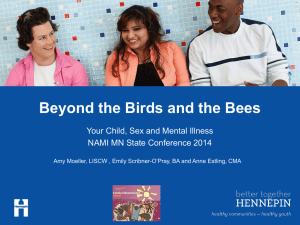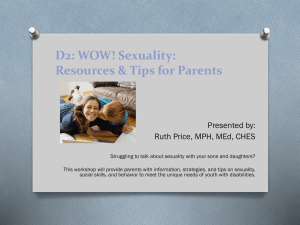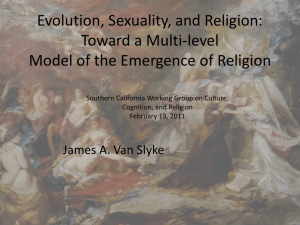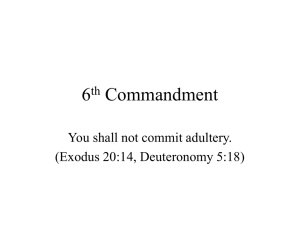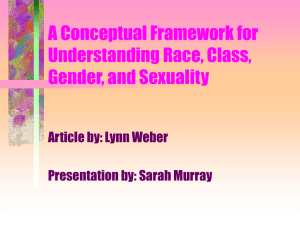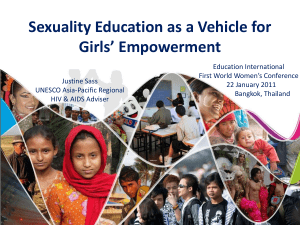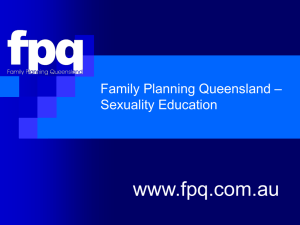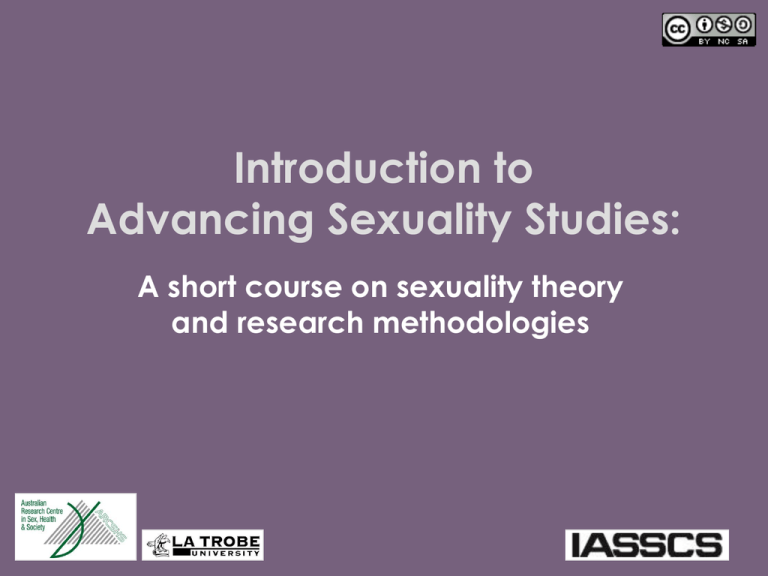
Introduction to
Advancing Sexuality Studies:
A short course on sexuality theory
and research methodologies
Developed by:
• The Australian Research Centre in Sex, Health and
Society, La Trobe University, Melbourne, Australia
and
• The International Association for the Study of
Sexuality, Culture and Society (IASSCS)
• With funding from The Ford Foundation
Available under an Attribution, Non-Commercial,
Share Alike licence from Creative Commons
2
Schedule
Learning activity
Time allowed
Course introduction, short course credits, schedule, aims
What is ‘sexuality’?
Introducing (y)ourselves
10 mins
5 mins
10 mins
Session 1. Short course background
Sexuality studies audit: mini lecture
Reflecting on experience
The project: mini lecture
40 mins
15 mins
10 mins
15 mins
Session 2. So, what is sexuality?
Defining sexuality: review
Definitions: mini lecture
45 mins
30 mins
15 mins
Conclusion
Total time:
TO BE ADDED
110 mins
( just under 2 hours)
3
What is ‘sexuality’?
• Introductory activity:
– Spend 5 minutes on your own, writing a short definition of
sexuality
– We will come back to this definition later
4
Introducing (y)ourselves
• In small groups:
(5 mins)
– What is your name, and what do you like to be called?
– Where are you from?
(Institution & position, geographical location)
– What is your major discipline or interest area?
– Tell us something about yourself that only your friends might
know
• Introduce each other to the whole group
(5 mins)
• The facilitator(s) will also introduce themselves
5
Session 1.
Short course background
6
Background
• Developed in response to growing recognition of the need
for advanced training in critical sexuality studies in
developing countries
• Began with an international audit of sexuality training
– Context-setting exercise for the development of course materials
– Results available from www.sexualitystudies.net
7
Sexuality studies audit
•
Identified 5 (overlapping) strands of sexuality research:
1.
2.
3.
4.
5.
HIV/AIDS
Sexology
Sexual & reproductive health (S&RH)
Gender studies
Critical sexuality studies
8
Sexuality in HIV/AIDS
• Based on public health frameworks
• Developing countries or were aimed at developing country
audiences
• Sexual behaviour = sexual risk
• Absence of diverse sexualities not deemed to be at risk of
HIV/AIDS e.g. lesbians
9
Sexuality in sexology
• Claim to broad multi-disciplinary basis
• Sexology is currently highly medicalised
• Concentration on sexual pathologies and dysfunctions….
– which are then ameliorated by medical practitioners and
therapists trained in psychology
10
Sexology sub-strands
• The search for origins or explanations for sexual behaviour
– For example, when hormones or genes are investigated as
influences in sexual orientation
• The behavioural and descriptive strands attempt to capture
the diversity of human sexual behaviour
– Often referred to as sex research
11
Sexuality in S&RH
• Wealthy industrialised countries
– Emphasis on issues of reproduction, less on sexually
transmissible infections
– Sexual and reproductive health is highly individualised
• The developing world
– Sexual and reproductive health is overtaking a previous focus on
sexually transmissible infections and questions of fertility
– Extends to social and political questions, including male and
female circumcision, and sexual violence
12
Sexuality in gender studies
• Often limited to study of women and sexuality; gender as a
system of power and relationships is often neglected
• Consequently, men are often absent from the discussions
except as perpetrators of violence or abuse
• Relationship between gender, sexuality and biological sex
sometimes poorly theorised
• Interdisciplinary nature of gender studies is often not
foregrounded when gender is used in the arena of health
13
Sexuality in CSS
• Feminism and sexual liberation movements in the 1960s
led to growing critique of sexology
• New theories of sexuality emerged, loosely described as
Critical Sexuality Studies (CSS)
• Multifaceted field, crossing several social science and
humanities disciplines but with a focus on the shifting
relationships of power, knowledge, context, and culture
14
Brainstorm
• Think about your personal experiences of involvement in
work related to sexuality
– Did this work fit under any of the five strands identified?
– Do the descriptions of the five strands sound familiar?
– In your experience, what were the restrictions or benefits of
working under any one particular strand?
(10 mins)
15
Project aims
• The short course will:
– Increase the quality and diversity of research and training activity
into human sexuality in the developing world
– Develop and enhance existing skills levels in undertaking
complex research into, and the development and application of
theory, in the field of Critical Sexuality Studies
– Connect with other multi-disciplinary investigations and initiatives
in international sexuality research and advanced training
Cont.
16
Project aims cont.
– Create a wider network of researchers and practitioners using
critical sexuality studies to investigate and contribute to cultural
analysis and production, global sexual and reproductive health,
HIV & AIDS, and justice in gender and sexuality
– Contribute to the development of an increased global dialogue on
human sexuality
17
Overall learning objectives
• Short course participants will:
– Increase their skills, knowledge and networking capacity in
sexuality research and theoretical development
– Initiate and stimulate dialogue between locally based knowledge
frameworks, CSS and global discussions of sexuality
– Work critically with advanced sexuality theory and research
methodologies
– Employ innovative methods for researching human sexuality in
specific settings
– Gain enhanced capacities to encourage sexuality research in
their own countries and regions
18
Modules
• Each module is designed for use:
– As a stand-alone or grouped with other modules
– To be incorporated into other courses, or
– As part of the complete short course
• Examples of module titles are:
–
–
–
–
–
Kinship and Sexuality
Sexuality, The Body and Personhood
Thinking About Men and Masculinities
Sex, Sexuality and Gender: Basic Concepts
Critical Sexuality Studies and Research Methodologies
19
Session 2.
So, what is sexuality?
20
Group work
• Form small groups
• Each person should briefly review their personal notes from
the start of the introduction
• Group discussion
(10 mins)
• Feedback from rapporteurs
(15 mins)
• Wrap-up
(5 mins)
21
Dictionary definitions
• The quality of being sexual or having sex … usage recorded 1836
• Possession of sexual powers, or capability of sexual
feelings … usage recorded 1879
• Recognition of or preoccupation with what is sexual;
allusions to sexual matters … usage recorded 1848
• A person's sexual identity in relation to the gender
[sic] to which he or she is typically attracted; the fact
of being heterosexual, homosexual, or bisexual …
proposed dictionary addition 2004
OED
22
Theoretical definition
Sexuality … [is] an historical construction which brings
together a host of different biological and mental
possibilities, and cultural forms — gender identity, bodily
differences, reproductive capacities, needs, desires,
fantasies, erotic practices, institutions and values — which
need not be linked together, and in other societies have not
been.
Weeks, J (2003: 7) Sexuality: Second Edition, Routledge
23
Conclusion
• FACILITATOR TO ADD:
– Which modules to be presented, estimated timings, and the aims
of each module
– An overview of key terms and concepts that will be used in the
modules presented
– • NB: This activity should offer the opportunity for
participants to check their own understandings of these
terms and concepts
24
• Module created by:
– Professor Gary W. Dowsett, Australian Research Centre
in Sex, Health and Society
Available under an Attribution, Non-Commercial, Share Alike licence from
Creative Commons
25



